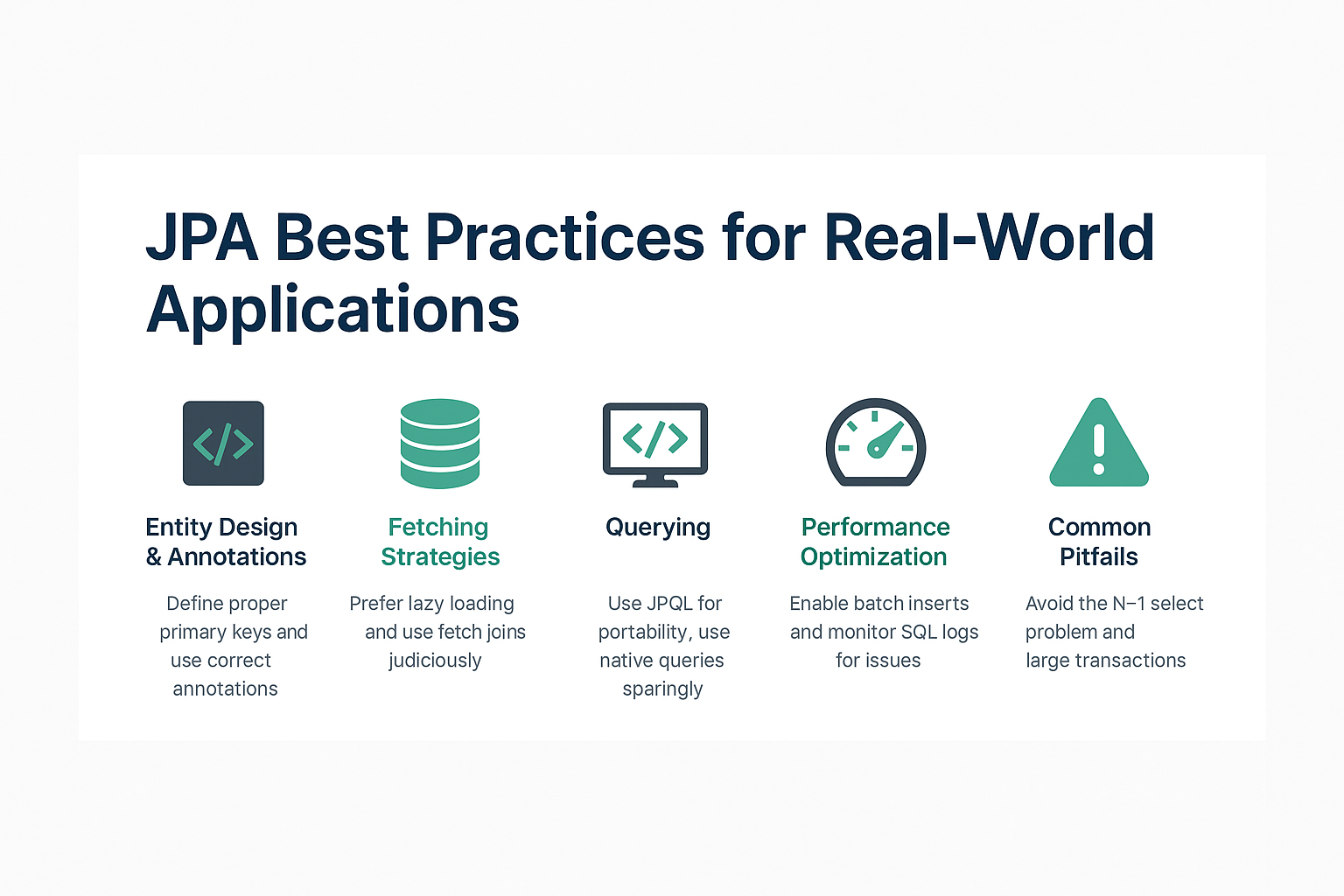The Java Persistence API (JPA) simplifies database access in Java applications by offering an ORM-based abstraction over SQL. While JPA improves developer productivity, improper usage can lead to performance bottlenecks, memory leaks, and even security issues.
This tutorial provides best practices for real-world JPA applications, covering annotations, queries, entity design, fetching strategies, Spring Boot integration, performance tuning, and pitfalls. Whether you’re building a SaaS application, enterprise system, or microservice, these guidelines will help you design production-ready JPA applications.
1. Entity Design Best Practices
1.1 Define Proper Primary Keys
@Entity
public class Customer {
@Id
@GeneratedValue(strategy = GenerationType.IDENTITY)
private Long id;
private String name;
}
- Prefer
@GeneratedValuewithSEQUENCEfor batch inserts. - Avoid using business keys (like email) as primary keys.
1.2 Use Correct Annotations
- Use
@Tablefor naming consistency. - Use
@Column(nullable=false)for constraints. - Use
@Enumerated(EnumType.STRING)to avoid ordinal mapping issues.
1.3 Avoid Bi-Directional Relationships Unless Necessary
Instead of this:
@OneToMany(mappedBy = "department")
private List<Employee> employees;
Prefer unidirectional relationships unless bi-directional navigation is critical.
2. Persistence Context Management
- Keep transactions short-lived.
- Use
em.clear()to avoid memory bloat in batch operations. - Treat persistence context as a classroom attendance register — it only tracks present entities.
Example:
for (int i = 0; i < items.size(); i++) {
em.persist(items.get(i));
if (i % 50 == 0) {
em.flush();
em.clear();
}
}
3. Fetching Strategy Best Practices
3.1 Use Lazy Loading by Default
@OneToMany(fetch = FetchType.LAZY)
private List<Order> orders;
Lazy loading avoids unnecessary joins.
3.2 Use Fetch Joins When Needed
SELECT c FROM Customer c JOIN FETCH c.orders
This prevents the N+1 select problem.
3.3 Use Entity Graphs for Reusability
@NamedEntityGraph(name = "Customer.withOrders",
attributeNodes = @NamedAttributeNode("orders"))
Entity graphs let you define reusable fetch plans.
4. Query Best Practices
4.1 Use JPQL for Portability
TypedQuery<Customer> q = em.createQuery(
"SELECT c FROM Customer c WHERE c.name = :name", Customer.class);
4.2 Use Criteria API for Dynamic Queries
CriteriaBuilder cb = em.getCriteriaBuilder();
CriteriaQuery<Customer> cq = cb.createQuery(Customer.class);
Root<Customer> root = cq.from(Customer.class);
cq.select(root).where(cb.equal(root.get("name"), "John"));
4.3 Use Native Queries Sparingly
Native queries break portability and should be limited to performance-critical cases.
5. Performance Best Practices
5.1 Enable Batch Inserts/Updates
spring.jpa.properties.hibernate.jdbc.batch_size=30
spring.jpa.properties.hibernate.order_inserts=true
spring.jpa.properties.hibernate.order_updates=true
5.2 Avoid Eager Fetching Everywhere
Eager fetching can result in huge queries with unnecessary joins.
5.3 Optimize Caching
- Use first-level cache (persistence context) wisely.
- Consider second-level cache for frequently read entities.
5.4 Monitor SQL Logs
spring.jpa.show-sql=true
spring.jpa.properties.hibernate.format_sql=true
This ensures you detect hidden N+1 queries.
6. Real-World Integration with Spring Boot
Repository Layer
public interface CustomerRepository extends JpaRepository<Customer, Long> {
@EntityGraph(attributePaths = "orders")
List<Customer> findByName(String name);
}
Service Layer
@Service
public class CustomerService {
@Autowired
private CustomerRepository repo;
@Transactional
public void processCustomers() {
List<Customer> customers = repo.findByName("John");
customers.forEach(c -> System.out.println(c.getOrders().size()));
}
}
7. Common Pitfalls
- N+1 Select Problem: Use fetch joins or batch fetching.
- Unnecessary CascadeType.ALL: Use selective cascades like
PERSISTorREMOVE. - Large Transactions: Keep transactions short and scoped.
- Detached Entities Confusion: Always merge before updating.
8. Best Practices Summary
- Prefer unidirectional relationships for simplicity.
- Use lazy fetching by default.
- Always monitor queries for N+1 problems.
- Use batch processing for large datasets.
- Manage persistence context size carefully.
- Keep transactions short and efficient.
📌 JPA Version Notes
- JPA 2.0: Introduced Criteria API, Metamodel.
- JPA 2.1: Added entity graphs, stored procedure support.
- Jakarta Persistence (EE 9/10/11): Migration from
javax.persistence→jakarta.persistence. No major behavioral changes.
Conclusion and Key Takeaways
- JPA provides a powerful ORM abstraction, but misuse can harm performance.
- Follow entity design, query, and transaction best practices for production apps.
- Always monitor SQL output to prevent N+1 problems.
- Use Spring Boot integration to simplify repository and service layer design.
FAQ (Expert-Level)
Q1: What’s the difference between JPA and Hibernate?
A: JPA is a specification; Hibernate is a popular provider with extended features.
Q2: How does JPA handle the persistence context?
A: It tracks managed entities and synchronizes them with the database at flush/commit.
Q3: What are the drawbacks of eager fetching in JPA?
A: It loads unnecessary data and can cause performance issues.
Q4: How can I solve the N+1 select problem with JPA?
A: Use fetch joins, entity graphs, or batch fetching.
Q5: Can I use JPA without Hibernate?
A: Yes, other providers like EclipseLink and OpenJPA exist.
Q6: What’s the best strategy for inheritance mapping in JPA?
A: SINGLE_TABLE for performance, JOINED for normalization.
Q7: How does JPA handle composite keys?
A: Using @IdClass or @EmbeddedId annotations.
Q8: What changes with Jakarta Persistence?
A: The package moved from javax.persistence to jakarta.persistence.
Q9: Is JPA suitable for microservices?
A: Yes, but lightweight alternatives may be better in some cases.
Q10: When should I avoid using JPA?
A: Avoid JPA in high-performance ETL jobs, analytics, or cases needing raw SQL control.
